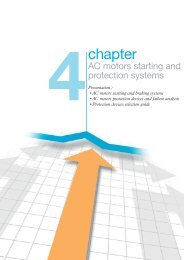Connect - Schneider Electric
Connect - Schneider Electric
Connect - Schneider Electric
You also want an ePaper? Increase the reach of your titles
YUMPU automatically turns print PDFs into web optimized ePapers that Google loves.
2 SUSTAINABLE DEVELOPMENT<br />
SCHNEIDER ELECTRIC’S COMMITMENT TO ENVIRONMENTAL PERFORMANCE<br />
60<br />
> 3. <strong>Schneider</strong> <strong>Electric</strong>’s Commitment<br />
to Environmental Performance<br />
This chapter deals with the environmental impact of the Group’s industrial activities. The products and solutions offered by <strong>Schneider</strong> <strong>Electric</strong><br />
which help reduce the environmental impacts of our customers’ activities are described in part 2, (page 52 ).<br />
3.1 Overview<br />
Context and aims<br />
<strong>Schneider</strong> <strong>Electric</strong> does not produce or distribute energy. It<br />
conceives and builds electrical products and proposes integral<br />
solutions for a number of market segments. The great majority of<br />
these products are installation components for energy management.<br />
They consume little energy compared with the devices they control,<br />
and the losses through dissipation are negligible compared with<br />
the energy in transit. Production activities, for their part, mainly call<br />
on assembly and control techniques and only minimally integrate<br />
procedures with a signifi cant environmental impact, such as the<br />
transformation and treatment of metals.<br />
With a company presence in more than 100 countries resulting<br />
from a continual rhythm of acquisitions, <strong>Schneider</strong> <strong>Electric</strong> applies<br />
a common environmental policy to all its entities and rolls out<br />
the same programs for certifi cation, reporting and performance<br />
objective throughout all its geographical locations.<br />
<strong>Schneider</strong> <strong>Electric</strong> commits to protecting the environment and health<br />
through the following objectives contained in the One company<br />
program:<br />
• to roll out ISO 14001 certifi cation and the Group’s environmental<br />
reporting to 100% of the industrial sites and logistics centres<br />
REGISTRATION DOCUMENT 2011 SCHNEIDER ELECTRIC<br />
(more than 50 people ) within two years after their creation or<br />
acquisition, and to the large tertiary sites (more than 300 people );<br />
• to roll out energy effi ciency monitoring solutions to 100 sites<br />
covering 75% of the Group’s total consumption (Energy Effi ciency<br />
Monitoring program);<br />
• to reduce energy consumption of sites by 4% per year, to limit<br />
SF 6 emissions to 1% of consumption (1.2% target revised to<br />
1%) and to reduce the air freight portion to 20% of long distance<br />
freight;<br />
• to monitor water consumption for all ISO 14001 sites and control<br />
deviations (+/- 10%);<br />
• to monitor VOC emissions (Volatile Organic Compounds) for all<br />
ISO 14001 sites holding emissions permits or emitting more than<br />
one tonne per year;<br />
• to achieve 2/3 of product revenue with products that have a life<br />
cycle analysis and chemical substance usage that is controlled<br />
and limited (Green Premium).<br />
Three performance indicators were set in the Planet and Society Barometer for the duration of the One program (2009-2011):<br />
Objectives for Year-End-2011 2011 2010 2009 2008<br />
1. 30,000 tonnes annual reduction of CO emissions 2<br />
2. 2/3 of products revenues gained with Green<br />
- 161,933 - 110,156 - 44,089 -<br />
Premium products 63.7% ▲ 26.1% 2.6% 0<br />
3. 2/3 of employees work in ISO 14001 certifi ed sites<br />
NM = indicator not monitored.<br />
70.4% ▲ 69.0% 63.7% 58.8%<br />
The 2008 performance serves as a starting value for the Planet & Society Barometer of the One program between 2009 and 2011.<br />
▲ 2011 Audited Indicators<br />
Please refer to pages 90 to 92 for the methodological presentation of indicators and the following pages for the analysis of the results<br />
(pages 61-64 for indicator 1, 64-67 for indicator 2 and 67 for indicator 3).

















